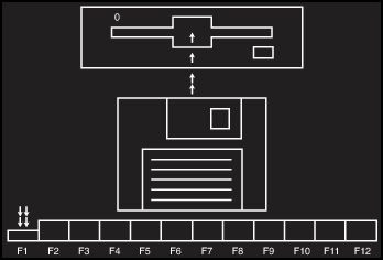Hardware Reference
In-Depth Information
The ROMs of most PCs are similar to the original IBM systems with which they are
compatible—with the exception of the ROM BASIC interpreter (also called Cassette BASIC).
It might come as a surprise to some PC users, but the original IBM PC actually had a jack on
the rear of the system for connecting a cassette tape recorder. This was to be used for loading
programs and data to or from a cassette tape. IBM included the cassette port because cassette
tapes were used by several early personal computers (including the Apple). Floppy drives
were expensive, and hard disks were not even an option yet. However, floppy drives came
down in price quickly right at the time the PC was first released, and the cassette port never
appeared on subsequent IBM systems. The cassette port also never appeared on PC-
compatible systems because floppy drives were cheap by the time they came out.
The reason for having BASIC in ROM was so the original PC could come standard with only
16KB of memory and no floppy drives in the base configuration. Many computer users at the
time either wrote their own programs in the BASIC language or ran BASIC programs written
by others. The BASIC language interpreter built into the ROM BIOS of these early IBM
systems was designed to access the cassette port on the back of the system; by having the
interpreter in ROM, all 16 kilobytes of RAM could be used to store a program.
Even after the cassette port was eliminated, IBM left the BASIC code in the motherboard ROM
until the early 1990s! I liken this to humans having an appendix. The ROM BASIC in those
IBM systems is sort of like a vestigial organ—a leftover that had some use in prehistoric
evolutionary ancestors but has no function today.
You can catch a glimpse of this ROM BASIC on older IBM systems that have it by disabling
all the disk drives in the system. In that case, with nothing to boot from, those systems
unceremoniously dump you into the strange (vintage 1981) ROM BASIC screen.
People used to dread seeing this because it usually meant that the floppy disk or hard disk they
were trying to boot from had become corrupted or had failed. Because no compatible systems
ever had the BASIC interpreter in ROM, they came up with different messages to display for
the same situations in which an IBM system would invoke this BASIC. The most confusing of
these was the message from AMI BIOS, which simply said
NO ROM BASIC - SYSTEM
HALTED
, which really meant that the system was incapable of booting.
With no valid MBR or bootable device found, some IBM systems display a screen using text graphic
characters that look similar to
Figure 5.11
.




